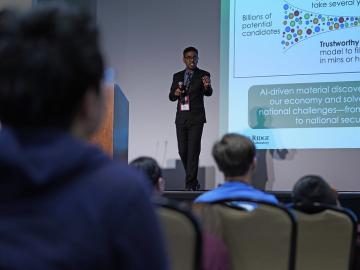
Filter News
Area of Research
- Advanced Manufacturing (1)
- Biology and Environment (68)
- Biology and Soft Matter (1)
- Clean Energy (49)
- Climate and Environmental Systems (1)
- Computational Biology (1)
- Electricity and Smart Grid (1)
- Fusion and Fission (4)
- Isotopes (2)
- Materials (32)
- Materials for Computing (6)
- National Security (15)
- Neutron Science (17)
- Nuclear Science and Technology (3)
- Quantum information Science (2)
- Supercomputing (40)
News Type
News Topics
- (-) Artificial Intelligence (48)
- (-) Biotechnology (11)
- (-) Energy Storage (29)
- (-) Environment (104)
- (-) Grid (25)
- (-) Materials Science (46)
- (-) Microscopy (20)
- (-) Nanotechnology (16)
- (-) Space Exploration (12)
- 3-D Printing/Advanced Manufacturing (42)
- Advanced Reactors (8)
- Big Data (27)
- Bioenergy (51)
- Biology (60)
- Biomedical (29)
- Buildings (19)
- Chemical Sciences (25)
- Clean Water (14)
- Climate Change (50)
- Composites (8)
- Computer Science (87)
- Coronavirus (17)
- Critical Materials (4)
- Cybersecurity (14)
- Decarbonization (46)
- Education (1)
- Emergency (2)
- Exascale Computing (27)
- Fossil Energy (4)
- Frontier (25)
- Fusion (31)
- High-Performance Computing (45)
- Hydropower (5)
- Isotopes (27)
- ITER (2)
- Machine Learning (22)
- Materials (43)
- Mathematics (7)
- Mercury (7)
- Microelectronics (2)
- Molten Salt (1)
- National Security (39)
- Net Zero (8)
- Neutron Science (47)
- Nuclear Energy (55)
- Partnerships (18)
- Physics (29)
- Polymers (8)
- Quantum Computing (21)
- Quantum Science (30)
- Renewable Energy (1)
- Security (11)
- Simulation (32)
- Software (1)
- Statistics (1)
- Summit (31)
- Sustainable Energy (47)
- Transformational Challenge Reactor (3)
- Transportation (27)
Media Contacts

The world’s fastest supercomputer helped researchers simulate synthesizing a material harder and tougher than diamond — or any other substance on Earth. The study used Frontier to predict the likeliest strategy to synthesize such a material, thought to exist so far only within the interiors of giant exoplanets, or planets beyond our solar system.

Two ORNL teams recently completed Cohort 18 of Energy I-Corps, an immersive two-month training program where the scientists define their technology’s value propositions, conduct stakeholder discovery interviews and develop viable market pathways.

Power companies and electric grid developers turn to simulation tools as they attempt to understand how modern equipment will be affected by rapidly unfolding events in a complex grid.

Researchers at the Department of Energy’s Oak Ridge National Laboratory and partner institutions have launched a project to develop an innovative suite of tools that will employ machine learning algorithms for more effective cybersecurity analysis of the U.S. power grid.

In the wet, muddy places where America’s rivers and lands meet the sea, scientists from the Department of Energy’s Oak Ridge National Laboratory are unearthing clues to better understand how these vital landscapes are evolving under climate change.

ORNL's Guang Yang and Andrew Westover have been selected to join the first cohort of DOE’s Advanced Research Projects Agency-Energy Inspiring Generations of New Innovators to Impact Technologies in Energy 2024 program. The program supports early career scientists and engineers in their work to convert disruptive ideas into impactful energy technologies.

Advanced materials research to enable energy-efficient, cost-competitive and environmentally friendly technologies for the United States and Japan is the goal of a memorandum of understanding, or MOU, between the Department of Energy’s Oak Ridge National Laboratory and Japan’s National Institute of Materials Science.

In May, the Department of Energy’s Oak Ridge and Brookhaven national laboratories co-hosted the 15th annual International Particle Accelerator Conference, or IPAC, at the Music City Center in Nashville, Tennessee.

Researchers at ORNL and the University of Maine have designed and 3D-printed a single-piece, recyclable natural-material floor panel tested to be strong enough to replace construction materials like steel.

Prasanna Balaprakash, a national leader in artificial intelligence, or AI, spoke to some of the highest achieving students in the country at the National Science Bowl in Washington D.C.


